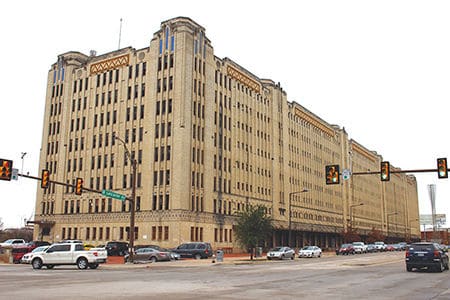The city of Fort Worth expects to release a temporary road construction easement on schedule June 20 to the owner of the historic T&P Warehouse, triggering a 90-day period in which the building owner must complete financing for a long-proposed renovation or face losing an $11 million public incentive, city officials said.
The Dallas investor Ola Assem, whose Cleopatra Investments bought the T&P in 1998, must show documents proving financing for the original $35 million mixed-use rehab she proposed when she secured the incentive in 2007 from the Fort Worth Lancaster Avenue tax increment finance district, under the terms of her agreements with the city.
“We’re going to enforce our contract unless we know what is going on,” said District 6 Councilman Jungus Jordan, chairman of the Lancaster TIF. If Assem doesn’t make the financing deadline, the TIF board could vote to rescind the incentive.
Assem is now planning a $106 million mixed-use renovation of the 580,000-square-foot building, according to documents she filed last fall with the Texas Department of Community and Housing Affairs for $51 million in tax-exempt financing and 4 percent tax credits.
Jordan said Assem hasn’t forwarded the new plan to the city or TIF.
“That has not been communicated to the council,” Jordan said. “When the TIF receives that concept, the council has asked for that presentation.”
The City Council, at some point, would have to approve a resolution of support or no objection for Assem’s tax-exempt funding application to proceed.
In an interview, Jordan confirmed Bank of America contacted the city Monday to say the bank had entered a memorandum of understanding with Assem to discuss potential financing for her development.
Jordan stressed there’s no guarantee of an eventual agreement between the bank and Assem.
“It’s not a contract,” Jordan said. But, he added, “I like that we’re moving forward. At the end of the day, all we want is that building redeveloped.”
At a Lancaster TIF board meeting on March 16, Michael Hennig, business and community development coordinator in the city’s economic development department, told members that the city expects to return a temporary construction easement to Cleopatra on June 20, the schedule under her TIF incentive agreement.
The easement is for the city’s Hemphill-Lamar Connector road and tunnel project, which will connect Hemphill Street to Taylor Street downtown by tunnel and run on the west side of the T&P Warehouse. That long-delayed road project is now underway.
Assem declined to respond to the developments.
In December, in emailed comments to the Business Press about whether she expected to meet the financing deadline, Assem said, “Cleopatra intends to comply with the terms of the TIF agreement, which requires coordination with the city on the Lamar-Hemphill connector project schedule. Cleopatra visits regularly with City engineers in order to coordinate its project schedule with the City’s Lamar- Hemphill connector project schedule.”
In its state funding pre-application, Cleopatra sought a “traditional carry forward” designation that would allow the firm up to 36 months to close on the tax-exempt bonds if it’s awarded them. Such designation is for large projects with complex financing; Assem proposes a financing package of bond, tax credit, bank loan, tax increment, and deferred developer fees.
“Cleopatra’s TDHCA pre-application seeks the maximum allowable flexibility on this project in order to accommodate the timeline for the Lamar-Hemphill connector project’s construction schedule and the coordination process,” Assume said in her remarks.
Based on Cleopatra’s detailed 257-page pre-application, the TDHCA board in the late fall approved an “inducement” resolution that allows Assem to file a full application.
Under her agreement with the TIF, Assem agreed to develop 260 apartments and ground-floor retail. That plan called for setting aside part of the building for future development into office or another use; that portion of the building was not part of the TIF agreement.
Assem’s plan today, according to her state filing, calls for development of the building into 500 efficiency, one, two and three-bedroom apartments, with ground-floor commercial and possibly a boutique hall. The residential units would be 100 percent affordable housing, with rents aimed at people who make 60 percent of area median income or less, according to the pre-application.
The apartments would be targeted at artists, and the development would be called Artist Loft at Fort Worth Town Square. Assem said in her remarks in December that affordable rents for creative people are a critical need in the city, as central city rents continue to rise.
The building will be a “premier location to live, work, play, practice, produce and display,” Assem said then. “It will contribute to and enhance the necessary cultural infrastructure through the direct assistance of artists (the most valuable cultural resource) by providing them with the necessary environment and stability, allowing them to contribute to the rich heritage of Fort Worth.”
Assem’s revised plan has drawn support from former State Sen. Wendy Davis, who represented Assem in securing an extension from the TIF board in 2012, state Rep. Nicole Collier, and Cathy Neece Brown, the Arts Council of Fort Worth’s interim president. All cited the need for affordable rents for artists.
The plan has drawn criticism from the Downtown Fort Worth, Inc. economic development nonprofit and Historic Fort Worth, which both said a mixed-income tenant mix is vital to West Lancaster’s revitalization. The Fort Worth Downtown Neighborhood Alliance said it favors affordable housing that’s “consistent with the strategic plan for downtown” and is opposed to Cleopatra’s proposal.
Many members of the business community and city staffers are also highly skeptical of Assem’s ability to execute a redevelopment plan of such a high magnitude.
City officials and business leaders have become increasingly frustrated as the circa 1931 building, which they view as central to the revitalization of West Lancaster, has sat vacant and deteriorating for years. Assem has said the challenges of meeting historical preservation guidelines and external factors like road construction around the property have hindered financing and development.
In her pre-application, Assem identified Atlantic Pacific Cos., a Miami, Fla., real estate firm as “100 percent member” of a limited liability corporation that will be co-developer. Atlantic Pacific executives have not responded to requests for interviews from the Business Press.
Jordan said Assem has not indicated she wants to ask the TIF for more money, but he said the TIF has fully committed the incremental tax revenue it expects to generate during the remainder of its life.
“There’s only so much money in the TIF,” he said.
T&P Warehouse
One of the last remaining Art Deco buildings in Fort Worth, the eight-story, 580,000 square-foot landmark was completed in 1931. It was primarily used for the storage, distribution and refrigeration of products, but also had offices and showrooms for the businesses there.
It was designed by Fort Worth architects Wyatt C. Hendricks and Herman P. Koeppe.








